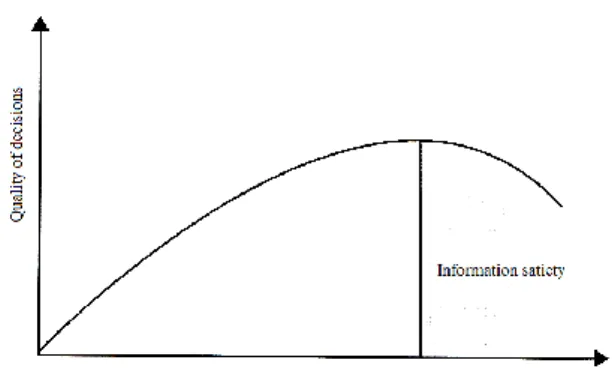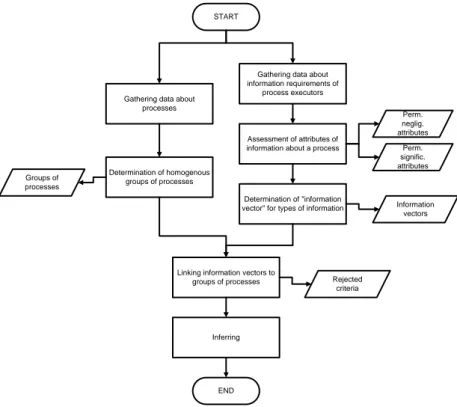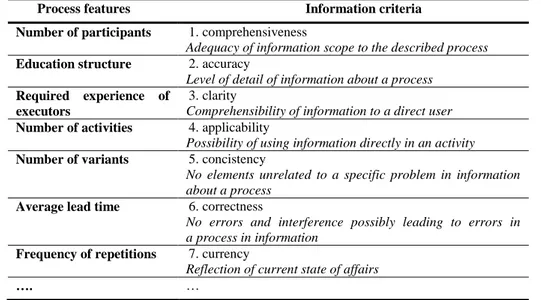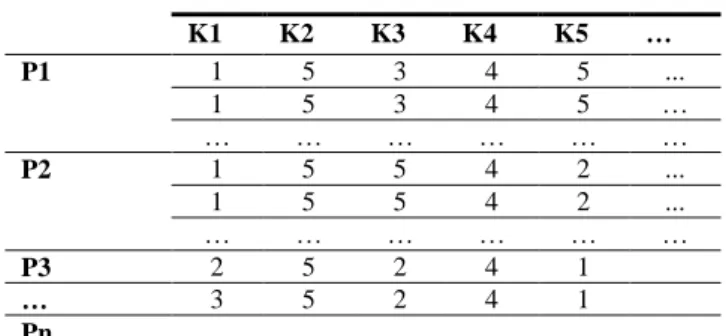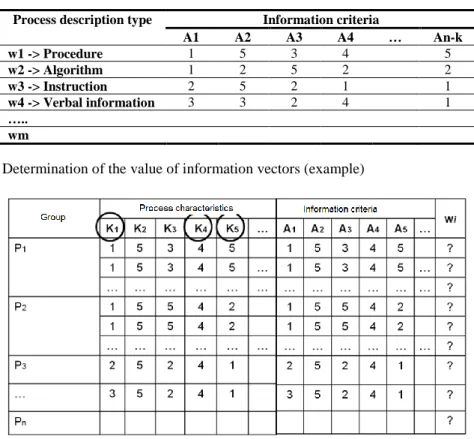EVALUATION OF DOCUMENTS’ QUALITY
IN QUALITY MANAGEMENT SYSTEMS
Łukasz Grudzień*
* Department of Management and Production Engeenering, Poznań University of Technology, Poznań, 60-132, Poland, Email: lukasz.grudzien@put.poznan.pl
Abstract The article presents the author's model of evaluation of the quality of documents in quality
management systems. Among others, descriptions of processes that provide users with information on the course or completion of a process are used in management systems for purposes of standardization of processes. In relation to the information satiety curve showing that once a certain level of amount of information is achieved, the quality of decisions taken on the basis of such information decreases, a problem arises with defining such an amount of information in a process description, in order to ensure as rational level for control, as possible. To achieve that, the author suggests a model whose main objective is to automate the activities of designating the characteristics of the process description (information quality) for a specific instance of a process. The initial elements of the model are activities of gathering the data on the process's features and the data on information related requirements of the executors of processes. Later on, the socalled information vector, pointing to a given type of description of a process, must be specified. Then, the types of descriptions of processes are linked with homoge-neous groups of processes that were specified on the basis of parameters that characterize processes.
Paper type: Research Paper Published online: 31 January 2014 Vol. 4, No. 1, pp. 81-90
ISSN 2083-4942 (Print) ISSN 2083-4950 (Online)
© 2014 Poznan University of Technology. All rights reserved.
1. INTRODUCTION
Information is one of the most valuable assets of modern companies. Infor-mation significantly impacts a company's effectiveness and efficiency. InforInfor-mation is present in practically every activity, from know-how, organization [of opera-tion], patents, technologies, through information about customers, competitors, to orders given by the management to employees, related to completion of opera-tional tasks. ISO 9000 defines information as important data (ISO 9001, 2005). Among other purposes, information is used for controlling processes and their standardization. For example, in quality management systems the controlling in-formation may be in the form of description of processes, procedures or instruc-tions. Providing appropriate information is of key importance. Still, the availability of information is not the only important aspect; the quantity and quality of infor-mation do matter, too. Increasing the quantity of inforinfor-mation does not lead to con-tinued increase of the quality of decisions made on the basis of such information. This phenomenon is called the information satiety curve (Fig. 1) (Abramowicz, 2008). According to it, as the quantity of information grows and reaches a certain "level", the effectiveness of decisions made on the basis of such information starts to drop. The same applies to processes. The more information about a process we have, the better we can manage it, but once a certain threshold is crossed, the in-creasing quantity of information does not improve the management. The decisions then taken are not better; instead, their efficiency drops. Information satiety brings about difficulty in taking decisions, which is caused by necessity to select infor-mation, presence of information noise, contradictory inforinfor-mation, etc.
Fig. 1 Information satiety curve (Abramowicz, 2008)
Hence, it is impossible to specify a standard level of quantity and quality of in-formation that would describe a process and that would be optimal from the point of view of the owner and executor of processes. The rational quantity of infor-mation may be different for various processes and even for the same processes executed across various organizations. In quality management systems we can
meet a variety of process descriptions, among others general maps and patterns, procedures describing sequences of actions performed within a process or detailed instructions that very accurately describe the execution of individual activities. There are also cases where a process is not documented with any kind of descrip-tion – its execudescrip-tion is based on spoken orders, experience of employees or their own decisions. ISO 9001 does not require organizations to follow specific forms of documenting, but rather specifies that an organization is expected to "ensure the availability of resources and information necessary to support the operation and monitoring" (ISO 9001, 2008), without specifying which of these and how accu-rately should be applied. The commentary section includes additional note that "the extent of the quality management system documentation can differ from one organ-ization to another due: the size of organorgan-ization and type of activities, the complexi-ty of processes and their interactions, and the competence of personnel". Hence, the following questions come to mind during the analysis of the described condition:
• Is it worth to standardize (describe / document) all processes?
• Which processes should be described? How to select such processes from all processes executed by the organization?
• For which cases should the level of details of process description increase? Is it possible to find a rule?
• How can information satiety curve be related to the level of details of in-formation about a process?
The level of details of process description can be related to the quality of infor-mation about a process, namely to that which is expected of a process by its user. The quality of information may be based on evaluation of the so-called information attributes, in other words information features. Consequently, new questions arise:
• What information attributes (information quality) are crucial for a given type of process?
• Can the level of details of a procedure be inferred from information attributes? A problem arises where for a given process a specified level of information must be found, so that the required level of details of a description is ensured for the cor-rect execution of a process, and at the same time there must be no "information over-load" that may result in a reduced rate of completion of a process or in errors, etc.
2. QUALITY OF DOCUMENTS
2.1. Evaluation of the quality of information as part of the document
There exist two main approaches on how to define the quality of information - quantitative and qualitative. As the article discusses information in infologic view,
it is then justified to evaluate it in qualitative approach, taking into account the user who interprets the received data to form information out of it.
Table 1 Description of the selected information criteria (based on Eppler, 2006)
No. Information
Crite-ria
Description Information
Quality Level
1 Comprehensiveness Is the scope of information adequate? (not too
much nor too little)
Community Level
(Rele-vance)
2 Accuracy Is the information precise enough and close
enough to reality?
3 Clarity Is the information understandable or
compre-hensible to the target group?
4 Applicability Can the information be directly applied? Is it
useful?
5 Conciseness Is the information to the point, void of
unneces-sary elements?
Product Level (Soundness)
6 Consistency Is the information free of contradictions or
convention breaks?
7 Correctness Is the information free of distortion, bias, or
error?
8 Currency Is the information up-to-date and not obsolete?
The quality of information is described with attributes applicable to mation. The literature proposes many attempts at defining such attributes of infor-mation. Most publications (Buśko et al, 1980), (Niedźwiedziński, 1987), (Gupta, 2000), (Kisielnicki, 1993), (Wang and Strong, 1996), (Weikum, 1999), (Pipino & Wang, 2002), (Kahn et al, 2002) consider a limited number of repeating attrib-utes. The differences mostly stem from the fact that these are listed in various con-figurations and/or differ only with nomenclature for a similarly understood attrib-ute. Most often, the authors specify such attributes as: validity, comparability, effi-ciency, usefulness, addressability, availability, etc. L. Floridi (2005) lists 27 attrib-utes and divides them into feature categories: modal (among others cohesion, actu-al existence), humanistic (accuracy, integrity), explaining (availability, variety) and constructive (correctness, validity).
A complex view on information attributes was presented by M. Eppler (2006). The researcher lists 70 criteria of information, but admits himself that this set should be limited because of its limited usefulness and because many listed criteria contain common elements. Hence, he narrows the information attributes down to the sixteen most important ones and divides them into four levels. Table 1 presents first two levels of these attributes, with short descriptions.
Authors F. Naumann and C. Rolker (2000) observe that it is of crucial im-portance to precisely define such criteria since there are so many of them. This is of paramount importance, especially for subjective evaluation, because the criterion's name itself does not always explain to the user what is subject to evaluation.
The proposition by E. Kolbusz (1993) may be considered a sort of consensus, where instead of ascribing attributes to information, a notion of "usefulness" is introduced. This notion synthetically covers all attributes present in the literature. Usefulness is relative and may be interpreted differently depending on the current needs of a user of information. A certain configuration of information attributes that constitute its usefulness is obtained for a specific user in a specific situation. These attributes become a measure of quality of information in qualitative ap-proach. The level of quality information may be determined by ascribing values to these attributes and by evaluating them.
2.2. Model of evaluation of information quality about a process
The paper also proposes a concept of a model, whose main function is to make it possible to infer information requirements of a description of a process on the basis of the process's features. The model is shown in Fig. 3. The model's obec-tive is to recognize and standardize information requirements in relation to a given type of a business process.
Gathering data about processes
Gathering data about information requirements of
process executors
Determination of homogenous groups of processes
Assessment of attributes of information about a process
Determination of "information vector" for types of information START END Perm. neglig. attributes Perm. signific. attributes Rejected criteria Linking information vectors to
groups of processes Information vectors Inferring Groups of processes
Fig. 2 Model of standardization of information requirements for specific types of processes (own work)
The first stage completed in the model is to gather information about processes. Following the assumptions of the process approach established in quality manage-ment systems, the process is defined as a set of activities that are interrelated or that interplay and that transform inputs into outputs (ISO 9000, 2005). Depending on the type of a process, its inputs and outputs may vary greatly. It is obvious that resources are needed for execution of a process. Their type and features will also be factors determining the level of required information for a process, so they also have to be included in the research. Features that parameterize all three generally accepted types of resources are proposed for the purpose of describing a process: human, infrastructural and environmental resources. Examples of features that cor-respond to individual groups of resources may be as follows: structure of education of participants, level of automation with the use of ICT or the number of variants of a process. Table 2 presents the examined process features.
Homogenous groups of processes that classify them in terms of similarity of features are determined on the basis of the obtained results and with the applica-tion of cluster analysis. Subsequently, these groups can be linked with specific requirements of process executors, and consequently the "quality" of their descrip-tion can be inferred. Fig. 3 shows an example of process grouping.
Data on processes are gathered along with data on information requirements of process executors in relation to descriptions of these processes. These require-ments are examined with the data obtained on the basis of quality descriptions of individual information attributes. The attributes to be analyzed were selected on the basis of a list proposed by Eppler (see Table 1).
Table 2 Examined process features and information criteria
Process features Information criteria
Number of participants 1. comprehensiveness
Adequacy of information scope to the described process
Education structure 2. accuracy
Level of detail of information about a process
Required experience of executors
3. clarity
Comprehensibility of information to a direct user
Number of activities 4. applicability
Possibility of using information directly in an activity
Number of variants 5. concistency
No elements unrelated to a specific problem in information about a process
Average lead time 6. correctness
No errors and interference possibly leading to errors in a process in information
Frequency of repetitions 7. currency
Reflection of current state of affairs
However, the number of attributes was reduced. Only those attributes that are relat-ed and relevant for a given type of information, namely a process description, were selected. Table 2 shows a proposition of these attributes. The attributes are examined in terms of expectations of information users. All attributes are evaluated with a 6-grade scale, where "6" stands for very high expectations and "1" for very low expectations.
Examinations of information requirements of users were carried out for all pro-cesses for which descriptions were prepared previously. Additionally, process users asses the level of satisfaction from the "quality" of the currently used information about a process. The data is gathered to verify whether the expectations of users coincide with the solutions proposes by the authors of documents and the designers of information systems. It is possible to determine which attributes are volatile and which ones are permanent (regardless of whether they were assessed well or poor-ly) on the basis of results of the evaluation. Volatile attributes will be important from the perspective of evaluation of the quality of information. Certain character-istic features (attribute values) for a given type of information about a process can be determined on the basis of such attributes.
Group Features K1 K2 K3 K4 K5 … P1 1 5 3 4 5 ... 1 5 3 4 5 … … … … … P2 1 5 5 4 2 ... 1 5 5 4 2 ... … … … … P3 2 5 2 4 1 … 3 5 2 4 1 Pn ... ... ... ... ... ...
Fig. 3 Grouping of processes in terms of their features (example)
Given that there is a limited number of types of descriptions of information, e.g. a procedure, a written instruction or a graphic instruction, for each type of such a description a reference "information vector" may be determined, namely values of individual attributes to characterize a given type of information about a process. Thus, a finite number m of information vectors (wm) can be obtained (see Fig. 4).
wm = [A1, A2, A3, …, Aj]
The cluster analysis performed on the analyzed processes (Fig. 2) allowed to distinguish a limited number of n groups of processes.
On the other hand, reference information vectors describe m type of information about a process. Ascribing average values of information expectations of users
to individual reference information vectors allows compilation of the obtained data and linking specific groups of processes with specific information vectors.
Pn –> wm
Process description type Information criteria
A1 A2 A3 A4 … An-k w1 -> Procedure 1 5 3 4 5 w2 -> Algorithm 1 2 5 2 2 w3 -> Instruction 2 5 2 1 1 w4 -> Verbal information 3 3 2 4 1 ….. wm
Fig. 4 Determination of the value of information vectors (example)
Fig. 5 Ascribing information vectors to groups of processes (example)
Before this can be done, it is important to determine, whether all described process parameters are related to the change of the information vector. To determine the ones that impact the features of information about a process, a stepwise regression analysis may be applied. It allows to obtain a limited set of features of a process that determine the quality of description of this process. This will greatly simplify the gathering of data about a process and shorten the entire inferring algorithm.
3. CONCLUSION
The following conclusions arise from the initial research. Requirements related to the quality of information that describe a process can be determined on the basis
of process parameter descriptions. Moreover, there are certain features of infor-mation that are permanent features characterizing a well described process, regard-less of the type of information that would form an example. Reference values of information attributes can be linked, namely information vectors can be linked with homogenous groups of processes obtained on the basis of process characteris-tics. The model presented in the article may further serve to build an algorithm for automating the determination of the expected level of quality of description of a process. It will be possible to obtain information on information requirements in relation to a specific process on the basis of the determined process features. The automation of this process may lead to reduced level of "bureaucratization" of management systems, a frequently imputed flaw, due to the fact that documented descriptions will only be generated where it is justified by the users' information requirements. Additionally, in areas where the documents will be created it will be possible to optimize them for quality of information (level of detail of the descrip-tion, applied discourse, description form, etc.). The documents will be prepared with a specific user in mind, in order to improve their clarity, comprehension and general usefulness.
REFERENCES
Abramowicz W. (2008), Filtrowanie informacji, Wydawnictwo Akademii Ekonomicznej w Poznaniu, Poznań
Buśko B., Filipek H., Śliwieński J. (1980), Wiarygodność informacji ekonomicznej w systemach informacyjnych, Polskie Wydawnictwo Ekonomiczne, Warszawa EN ISO 9000:2005, Quality management systems - Fundamentals and vocabulary, ISO, Brussels EN ISO 9001:2008, Quality management systems - Requirements, ISO, Brussels
Eppler M. J. (2006), Managing Information Quality, Springer, Heidelberg
Floridi L. (2005), Information Ethics, its Nature and Scope, Computer & Society 34.5 Gupta U. (2000), Information Systems: Success in the 21st Century, Prentice Hall Canada Inc. Kahn B. K., Strong D. M., Wang R. Y. (2002), Information quality benchmarks: product
and service performance. Commun. ACM 45, 4 (Apr. 2002),
Kisielnicki J. (1993), Informatyczna infrastruktura zarządzania, Wydawnictwo Naukowe PWN, Warszawa
Kolbusz E. (1993), Analiza potrzeb informacyjnych przedsiębiorstwa. Podstawy metodologiczne. Wyd. Naukowe Uniwersytetu Szczecińskiego, Szczecin
Naumann F., Rolker C. (2000), Assessment methods for information quality criteria, Proceedings of the International Conference on Information Quality (IQ}
Niedźwiedziński M. (1987), Cechy informacji – próba systematyzacji, Jakość danych w systemach informacyjnych (red. J. Oleński) Seria: Systemy informatyczne nr 1, Wydawnictwo OBSR, Warszawa
Pipino L. L., Lee Y. W., Wang R. Y. (2002), Data quality assessment. Commun. ACM 45, 4 (Apr. 2002)
Wang R.Y., Strong D. M. (1996), Beyond accuracy: What data quality means to data consumers, Journal on Management of Information Systems
Weikum G. (1999), Towards guaranteed quality and dependability of information systems, In Proceedings of the Conference Datenbanksysteme in Burio, Technik und Wissenschaft (BTW), Freiburg
BIOGRAPHICAL NOTES
Łukasz Grudzień is a graduate of Poznan University of Technology, the faculty of Mechanical Engineering and Management, specialization Corporate Management. He also completed postgraduate studies in Computer Science in Management and Administration in the Institute of Computing Science of Poznan University of Technology. At present he works as an assistant in the division of Management and Production Engeenering at PUT. He works in the following areas: quality management systems, their integration with the other management systems as well as the role of information in the management systems, including the estimation of information quality. He has great experience as a consultant in implementing the management systems both in the companies of SME sector as well as large organizations. He is the manager of the management systems in the consultation unit Quem. He has certificates from the leading auditor of the quality management systems, environmental one as well as the information security.
